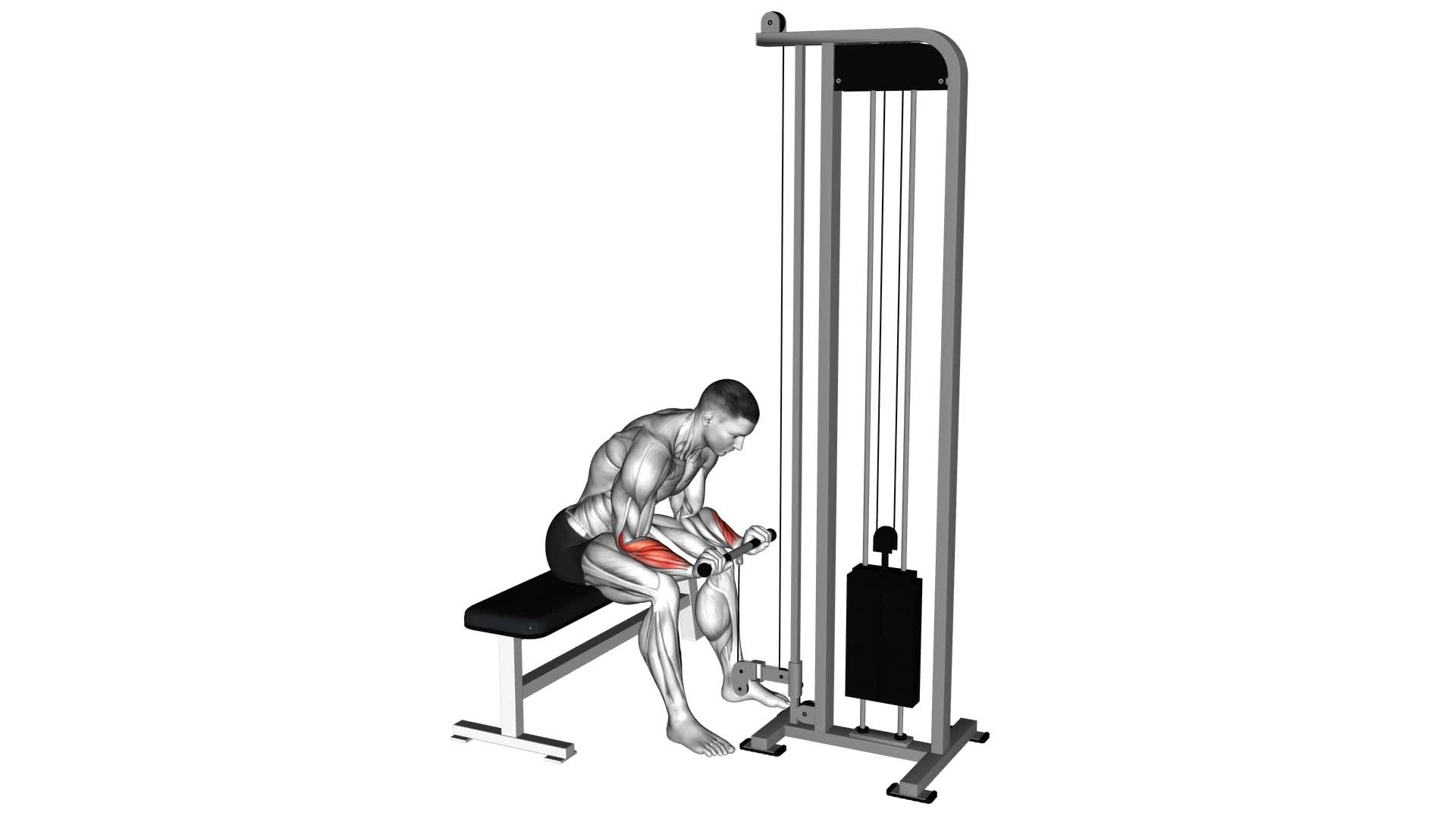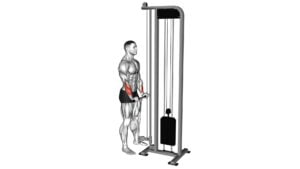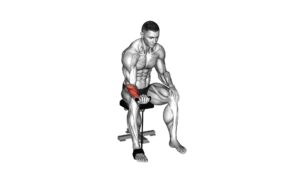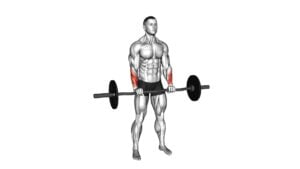Cable Reverse Wrist Curl – Video Exercise Guide & Tips

Are you looking to strengthen your wrists and forearms? The cable reverse wrist curl is the exercise for you. In this video guide, we'll show you the proper form and technique, as well as variations and modifications to challenge yourself.
Watch This Exercise Video
Avoid common mistakes and make the most of your workout with our expert tips. Get ready to improve your grip strength and achieve better overall arm strength.
Let's get started!
Key Takeaways
- Cable reverse wrist curls can strengthen forearm muscles and improve grip strength.
- They can help prevent wrist strains and sprains.
- The exercise targets specific forearm muscles and can be beneficial for injury prevention and muscle activation.
- Proper form and technique, as well as avoiding common mistakes, are important for maximizing results.
Benefits of Cable Reverse Wrist Curl
By performing cable reverse wrist curls, you can strengthen your forearm muscles and improve your grip strength. This exercise is beneficial for injury prevention and muscle activation. Cable reverse wrist curls specifically target the muscles in your forearms, including the flexor carpi radialis, flexor carpi ulnaris, and extensor carpi radialis longus.
Strengthening these muscles can help prevent injuries such as wrist strains and sprains that can occur during activities that require a strong grip, such as weightlifting or rock climbing.
To perform cable reverse wrist curls, start by attaching a cable handle to a low pulley machine. Stand with your feet shoulder-width apart, facing the machine. Grasp the handle with an overhand grip, palms facing down. Keep your arms straight and your elbows close to your sides. Begin by flexing your wrists, bringing your hands upward towards your forearms. Hold for a moment, then slowly lower your hands back down to the starting position. Repeat for the desired number of repetitions.
Remember to start with a weight that allows you to perform the exercise with proper form and control. As you progress, you can gradually increase the weight to continue challenging your muscles.
Incorporating cable reverse wrist curls into your workout routine can help strengthen your forearms, improve your grip strength, and reduce the risk of wrist injuries.
Proper Form and Technique
To perform cable reverse wrist curls with proper form and technique, follow these steps:
- Stand facing a cable machine with your feet shoulder-width apart and knees slightly bent.
- Grasp the handle of the cable attachment with an overhand grip, palms facing down.
- Keep your elbows tucked in close to your sides and your wrists in line with your forearms.
Now, let's talk about some common mistakes to avoid and how to maintain proper form during cable reverse wrist curls:
- Avoid using excessive weight, as this can lead to poor form and increase the risk of injury. Start with a lighter weight and gradually increase as you become more comfortable and confident.
- Don't let your wrists bend or flex during the exercise. Keep them straight and in line with your forearms throughout the movement.
- Avoid using momentum to lift the weight. Focus on using your forearm muscles to control the movement and keep it slow and controlled.
Remember, maintaining proper form is crucial for maximizing the effectiveness of the exercise and preventing injuries. So, pay attention to your technique and make sure to adjust the weight and form accordingly.
Happy lifting!
Variations and Modifications
To add variety to your wrist workout, you can incorporate different variations and modifications of the cable reverse wrist curl exercise. By using different equipment options, you can target specific muscle groups and enhance the effectiveness of your workout.
One variation you can try is using a different grip on the cable handle. Instead of using an overhand grip, try an underhand grip to target the muscles in your forearm from a different angle. This can help to develop a well-rounded forearm and improve overall strength.
Another modification you can make is using a different type of equipment. Instead of using a cable machine, you can use dumbbells or a barbell to perform the reverse wrist curl. This can help to challenge your muscles in a different way and add variety to your routine.
By incorporating these variations and modifications into your wrist workout, you can keep your routine interesting and continue to make progress. However, it's important to remember to always maintain proper form and technique to avoid injury.
In the next section, we'll discuss common mistakes to avoid when performing the cable reverse wrist curl exercise.
Common Mistakes to Avoid
Avoid these common mistakes when performing the cable reverse wrist curl exercise to maximize your results and prevent injury. Proper form is essential to ensure you engage the correct muscles and avoid unnecessary strain on your wrists. Here are some common errors to watch out for:
- Gripping the handle too tightly: It's important to maintain a comfortable grip on the handle without squeezing it too tightly. This excessive gripping can put unnecessary strain on your wrists and limit the effectiveness of the exercise.
- Using too much weight: Start with a lighter weight and gradually increase as you build strength. Using too much weight can cause your wrists to bend unnaturally and increase the risk of injury.
- Relying on momentum: The cable reverse wrist curl exercise should be performed in a slow and controlled manner. Avoid swinging or using momentum to lift the weight, as this takes away from the targeted muscles and increases the chance of wrist injury.
To prevent wrist injury, it's also important to keep your wrists in a neutral position throughout the exercise. Avoid bending or flexing your wrists excessively, as this can strain the tendons and ligaments.
Tips for Maximizing Results
To optimize your results, incorporate these tips into your cable reverse wrist curl routine.
Maximizing grip strength is crucial for improving your performance in various activities such as weightlifting, rock climbing, and even everyday tasks like carrying groceries. To enhance your grip strength, focus on squeezing the handle tightly during the exercise. This will engage the muscles in your forearms and improve their strength and endurance.
Additionally, make sure to maintain proper form throughout the movement. Keep your wrists in a neutral position and avoid any excessive bending or extending. This will help prevent unnecessary strain and injury. Remember, the goal is to target the muscles in your forearms, so avoid using momentum or swinging your arms.
Lastly, don't forget the importance of wrist flexibility. Incorporate stretching exercises for your wrists before and after your cable reverse wrist curl routine to increase your range of motion and improve overall flexibility.
Frequently Asked Questions
How Many Sets and Reps Should I Do for the Cable Reverse Wrist Curl Exercise?
To get the most out of the cable reverse wrist curl exercise, it's important to know how many sets and reps to do. By incorporating different sets and reps into your routine, you can challenge your muscles and improve your wrist strength.
Additionally, if you don't have access to cable equipment, there are alternative equipment options that can still allow you to perform this exercise effectively.
Follow these guidelines to ensure you're getting the most out of your workout.
Can I Use Dumbbells Instead of a Cable Machine for the Cable Reverse Wrist Curl?
Yes, you can use dumbbells instead of a cable machine for the cable reverse wrist curl exercise. While the cable machine provides a constant tension throughout the movement, dumbbells can still effectively target and strengthen your wrist extensors.
However, keep in mind that using a cable machine offers the advantage of adjustable resistance and a smoother range of motion. So, if you have access to a cable machine, it's recommended to use it for the best results.
Is It Normal to Feel a Burning Sensation in My Forearms During the Exercise?
Feeling a burning sensation in your forearms during the exercise is normal. It indicates that your forearm muscles are being worked effectively.
The Cable Reverse Wrist Curl targets these muscles and helps to strengthen and tone them.
Make sure to maintain proper form and use a weight that challenges you without causing excessive strain.
If the burning sensation becomes too intense or painful, consider reducing the weight or taking short breaks during the exercise.
Should I Use a Wrist Support or Wrap for Added Stability During the Cable Reverse Wrist Curl?
Using a wrist support or wrap can provide added stability during the cable reverse wrist curl. It helps to reduce the risk of injury and maintain proper form throughout the exercise. Wrist support benefits include improved grip strength and increased wrist stability.
However, if you prefer alternatives to wrist support, you can focus on strengthening your forearm muscles through exercises like wrist curls and reverse curls. These exercises can help build stability and reduce the need for additional support.
Can the Cable Reverse Wrist Curl Help Improve Grip Strength for Other Exercises Like Deadlifts or Pull-Ups?
The cable reverse wrist curl is a great exercise to improve grip strength for other exercises like deadlifts or pull-ups. By targeting the muscles in your forearms and wrists, this exercise helps to strengthen your grip and increase your overall strength.
Incorporating grip strength exercises into your workout routine has several benefits, including better performance in various exercises, reduced risk of injury, and increased muscle activation.
To improve grip strength for other exercises, try incorporating exercises like farmer's carries, plate pinches, and towel pull-ups into your routine.
Conclusion
In conclusion, the cable reverse wrist curl is a beneficial exercise for strengthening the muscles in your wrists and forearms.
By using proper form and technique, you can maximize the results of this exercise.
Remember to avoid common mistakes and consider variations or modifications to keep challenging your muscles.
With consistent practice, you can improve your wrist strength and enhance your overall fitness routine.

Author
Years ago, the spark of my life’s passion ignited in my mind the moment I stepped into the local gym for the first time. The inaugural bead of perspiration, the initial endeavor, the very first surge of endorphins, and a sense of pride that washed over me post-workout marked the beginning of my deep-seated interest in strength sports, fitness, and sports nutrition. This very curiosity blossomed rapidly into a profound fascination, propelling me to earn a Master’s degree in Physical Education from the Academy of Physical Education in Krakow, followed by a Sports Manager diploma from the Jagiellonian University. My journey of growth led me to gain more specialized qualifications, such as being a certified personal trainer with a focus on sports dietetics, a lifeguard, and an instructor for wellness and corrective gymnastics. Theoretical knowledge paired seamlessly with practical experience, reinforcing my belief that the transformation of individuals under my guidance was also a reflection of my personal growth. This belief holds true even today. Each day, I strive to push the boundaries and explore new realms. These realms gently elevate me to greater heights. The unique combination of passion for my field and the continuous quest for growth fuels my drive to break new ground.







